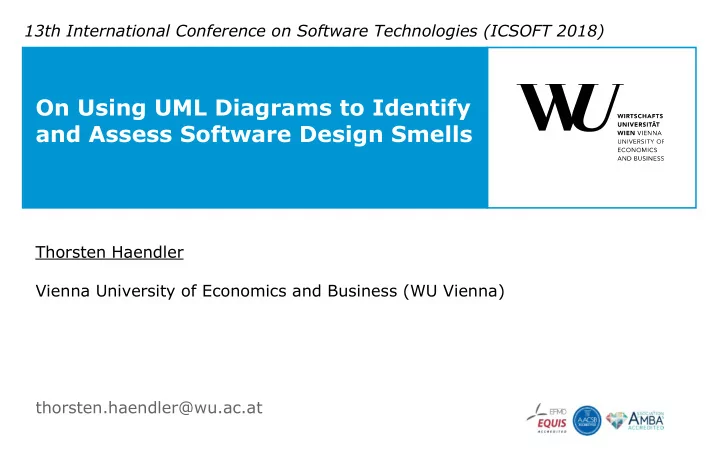

13th International Conference on Software Technologies (ICSOFT 2018) On Using UML Diagrams to Identify and Assess Software Design Smells Thorsten Haendler Vienna University of Economics and Business (WU Vienna) thorsten.haendler@wu.ac.at
Baseline and Hypothesis deficiencies in software design/architecture can impede development progress → software refactoring important, but understood as difficult task ( Tempero et al., 2017 ) identification of bad smells as step in the refactoring process software design smells violating software design principles, i.e., Abstraction , Encapsulation , Modularization and Hierarchy ( Suryanarayana et al., 2014 ) diagrams of the Unified Modeling Language (UML) as quasi-standard for software design documentation UML software Software design diagrams design smells → Hypothesis : UML diagrams are suitable for identifying and assessing software design smells 2
3 Questions 1. Why are design reviews important/necessary? → Relevance of design reviews for smell identification 2. Are UML diagrams suitable for identifying software design smells? → Representability of software design smells via UML diagrams 3. What other aspects need to be considered? → Further challenges for UML-based smell identification 3
Relevance of design reviews 1/4: smell coverage at least 25 software design smells ( Suryanarayana et al., 2014 ) smell coverage of popular smell detection tools: covered covered smells in total design smells DECOR 9 4 JDeodorant 5 3 EMF Refactor 27 6 In addition: smell detection tools mostly only available for a few programming languages → manual identification of missed smell candidates (false negatives) 4
Relevance of design reviews 2/4: smell false positives smell symptoms can also be the result of conscious constructs ( Fontana et al. 2016 ) 2 groups: → imposed smells, e.g., as result of applying a design pattern → inadvertent smells, e.g., as result of development tools (e.g., code generators) Fontana et al. : false positives for at least 7 kinds of software design smells → manual assessment of tool-identified smell candidates in order to discard false positives 5
Relevance of design reviews 3/4: examples Cyclic-dependend Modularization (aka CyclicDependency ) → not detected by any of the three smell detectors → false positive: e.g., Visitor design pattern with double-dispatch protocol (visitor and visited element) MessageChain (as kind of BrokenModularization ) → only detected by DECOR → false positive: e.g., Facade design pattern 6
Relevance of design reviews 4/4: code vs. design reviews issues described above illustrate → human investigation in terms of code/design review necessary but : investigation of source code directly is tedious and error-prone some design issues do not manifest via source code → source code only static representation (no run-time behavior) → abstraction from code to design level necessary UML diagrams popular and often available in software projects → with notations for structural and behavioral design aspects 7
Representability of software design smells via UML diagrams 1/4: objective UML class and sequence diagrams most popular for representing structural and behavioral design aspects respectively Objective : investigate whether diagrams provide the information needed for representing and identifying the smells minimal structural and behavioral design scope → all elements affected by the smell symptoms as described by (Fowler et al. 1999) and ( Suryanarayana et al., 2014 ) exemplary synthetic UML diagrams reflecting the identified design scope 8
Representability of software design smells via UML diagrams 2/4: Abstraction smells 9
Representability of software design smells via UML diagrams 3/4: Modularization smells 10
Representability of software design smells via UML diagrams 4/4: preliminary findings by only reviewing UML class diagrams most design smells are not identifiable (except a few Hierarchy smells) Problems : - limited expressiveness of dependencies class diagrams (e.g., Dependency as relationship between Classifiers , not between methods/fields - some smells are indicated by behavioral aspects, e.g., for expressing responsibilities or usage contexts/scenarios (e.g., MultifacedAbstraction , DataClump ) by combining UML class and sequence diagrams (which reflect usage scenarios) → all symptoms and design scopes of selected design smells can be represented 11
Further challenges for UML-based smell identification Consistent and up-to-date UML-based design documentation → approaches for reverse-engineering UML diagrams Locating the relevant design context especially in large reverse-engineered diagrams → approaches for interactively exploring/tailoring the diagrams but: no approaches for exploration/tailoring with regard to the smell scope Distinctiveness of design smells among each other (very similar appearance) to identify false positives (e.g., visitor pattern) → demands for experienced software design experts 12
Conclusion and next steps 1/2 Summary : difficulties in smell detection demand for design reviews, e.g., via UML diagrams we investigated the representability of 14 kinds of software design smells via UML class and sequence diagrams Preliminary results : UML class diagrams mostly not sufficient (except for a few Hierarchy smells) → but by combining UML class and sequence diagrams all selected design smells can be represented further challenges exist, e.g., in identifying the relevant design scope, especially in UML sequence diagrams reflecting multiple usage scenarios 13
Conclusion and next steps 2/2 Discussion : conceptual and exploratory character → but first systematization with preliminary results Limited regarding: diagram types, kinds of smells and selected examples (small, synthetic) Future Work : → empirical study for comparing occurrence in source code with appearance in reverse-engineered UML design diagrams → intelligent tuoring system (ITS) for supporting in acquiring techniques for smell assessment and refactoring; with tailorable UML diagrams as decision support, also see ( Haendler et al., 2017 ) 14
Thank you for your attention! Questions & Discussion thorsten.haendler@wu.ac.at
Appendix 1/2: Difficulties in smell identification 16
Appendix 2/2: Representability of software design smells via UML diagrams: Encapsulation and Hierarchy smells 17
Recommend
More recommend